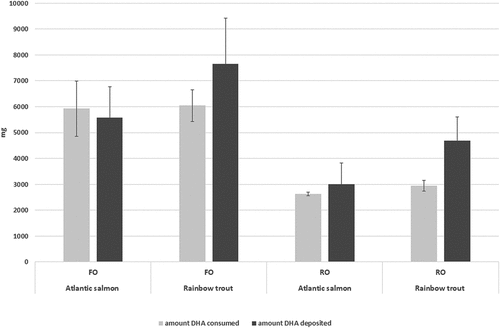Figures & data
Table 1. Feed components (g kg−1) and proximate compositions of the experimental diets (% of diet as is).
Table 2. Fatty acid composition (% of total fatty acids) of the experimental diets.
Table 3. Weight, length, growth rate (SGR, and TGC), feed conversion ratio (FCR), condition factor (CF), dress-out percentage (DP), and hepatosomatic index (HSI) of fish fed the experimental diets (mean ± SEM, n = 2).
Table 4. Apparent digestibility coefficients of total lipids and some fatty acids in Atlantic salmon and rainbow trout fed the experimental diets (mean ± SEM, n = 2).
Table 5. Whole-body total lipid and fatty acid profiles (% of total fatty acids), and quantitative content of EPA and DHA (g/100 g), in Atlantic salmon and Rainbow trout fed the experimental diets. Initial values are included, but statistical comparisons include the final content of fish from the different dietary groups only (mean ± SEM, n = 2).
Table 6. Apparent retention coefficients of total fat and fatty acids ingested in Atlantic salmon and rainbow trout fed the experimental diets (mean ± SEM, n = 2).
Figure 1. Amount of DHA consumed versus amount of DHA deposited in an average fish (mean ± SEM, n = 2).

Table 7. Liver total lipid (%) and fatty acid profile (% of total fatty acids) in Atlantic salmon and Rainbow trout fed the experimental diets (mean ± SEM, n = 2).
